The Rose of Sharon is a vibrant and resilient shrub that graces many gardens with its beautiful blooms. These plants, while relatively easy to care for, do require some maintenance to maintain their health and keep their appearance tidy. One crucial element of this upkeep is pruning. Pruning not only helps in shaping the plant but also stimulates the growth of new flowers. This comprehensive guide will walk you through the process of expertly pruning the Rose of Sharon, ensuring optimal results.
A Guide to Cultivating a Rose of Sharon
Pruning a Rose of Sharon is best done in early spring, right before the new growth begins. This timing ensures optimal results and promotes the health and vitality of the plant. This is typically March to early April, depending on your geographical location. Pruning at this time will promote a profusion of blooming flowers in the summer. Delaying the pruning too late into spring risks cutting off new buds, which reduces the shrub’s blooming potential.
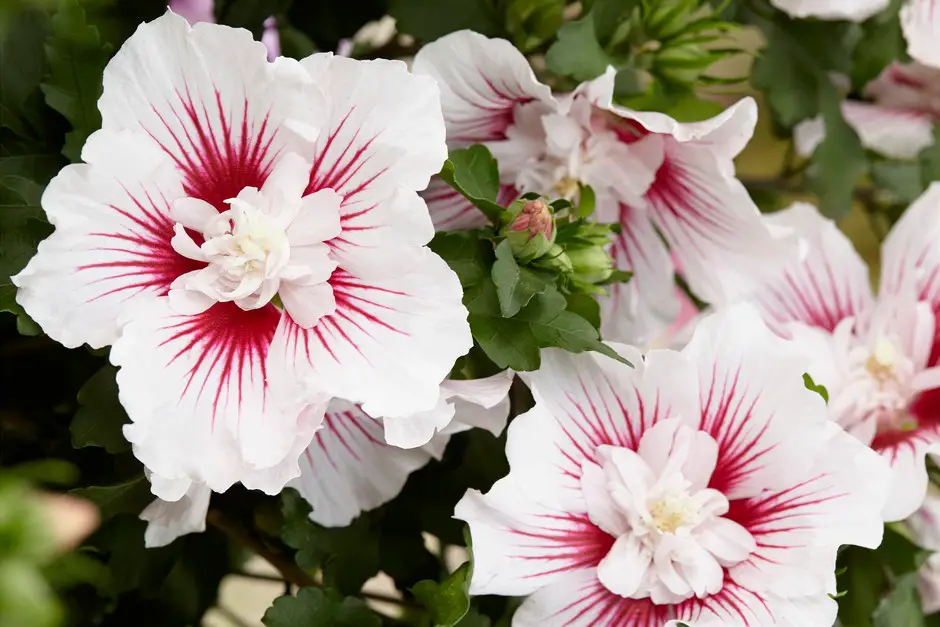
Pruning Techniques
To promote the overall health of the shrub, begin by eliminating any dead, diseased, or damaged branches. Trim the branches by cutting them back to the base of the shrub or to a healthy bud that faces outward. This help guides new growth outward for a better shape. Thinning out the branches in the middle of the shrub will also help to improve air circulation, reducing the risk of diseases.
With these techniques, your Rose of Sharon will be well on its way to producing a stunning display of flowers throughout the summer and well into the fall.[2]
Benefits of Pruning
Pruning a Rose of Sharon is not merely a cosmetic exercise; it holds significant benefits for the plant’s health and flowering capacity. Pruning helps maintain a balanced structure, which not only enhances the shrub’s aesthetic appeal but also promotes its stability against winds and heavy flower loads. Regular removal of dead or diseased branches prevents the spread of infections and pests, thereby safeguarding the overall health of the plant.
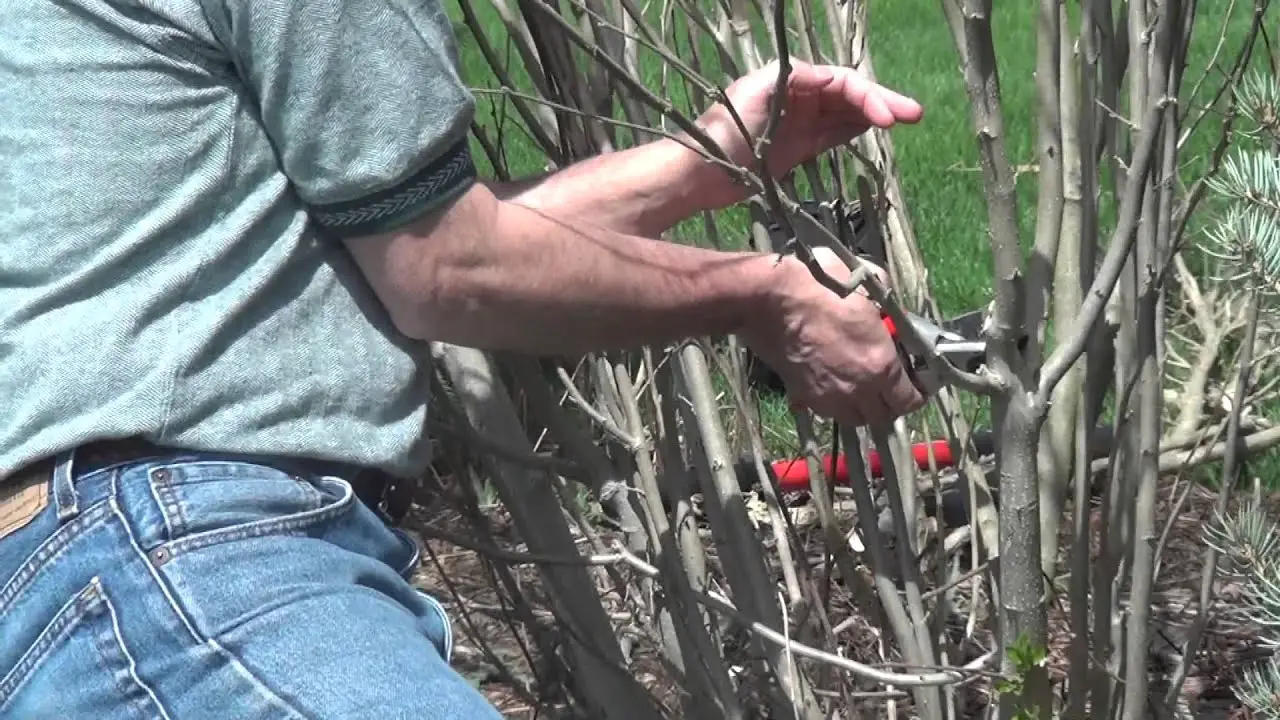
Additionally, pruning encourages the growth of new buds and increases flowering potential, resulting in a vibrant, colorful display during the blooming season. Lastly, This promotes improved air circulation and better penetration of sunlight, which are crucial for the plant’s growth and the prevention of diseases. Thus, consistent pruning is a crucial component of Rose of Sharon’s care.
Rose of Sharon Pruning Manual
Tools Needed for Pruning
To prune Rose of Sharon effectively, you will need some essential gardening tools. These include:
- Pruning Shears: Perfect for effortlessly trimming slender branches and twigs. Opt for a high-quality pair that makes clean, precise cuts to prevent damaging the plant.
- Lopping Shears: These are perfect for trimming thicker branches that are hard to cut with pruning shears.
- Pruning Saw: For those that are extremely thick or located in hard-to-access areas, a pruning saw is helpful.
- Gloves: Protect your hands from thorns and rough bark with a good pair of gardening gloves.
Before you begin, make sure to clean and sharpen all of your tools. This will ensure clean cuts and help prevent the spread of disease.[1]
How to Properly Prune the Rose of Sharon
Begin your pruning process by standing back and carefully observing the overall shape and structure of your Rose of Sharon. Identify and remove any branches that are dead, damaged, or diseased. Once you have a clear plan, put on your gloves, grab your pruning tools, and begin.
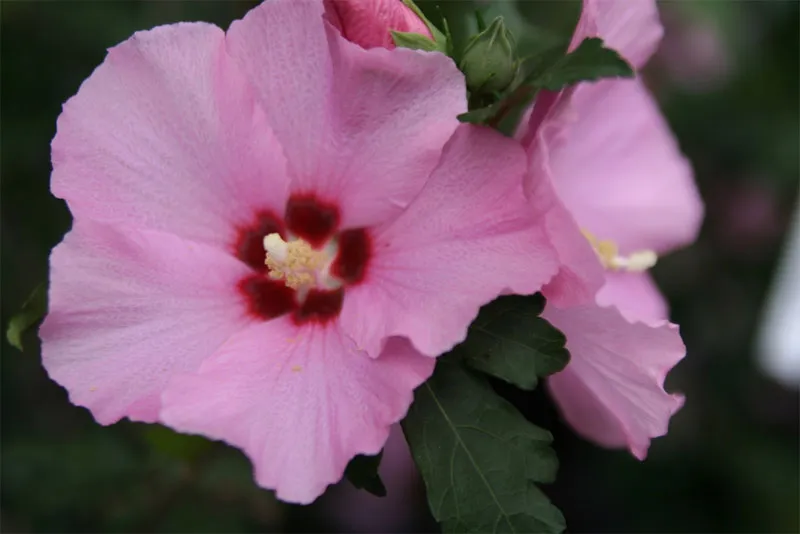
Start by removing all dead, damaged, or diseased branches using your pruning shears or lopping shears depending on the thickness of the branches. Make your cut at the base of the branch or just above a leaf node or bud facing outwards.
Next, trim the remaining branches to manage the size of the shrub and to create your desired shape. Make sure to prune branches at a 45-degree angle, about 1/4 inch above a bud that is facing toward the outside of the shrub. This encourages outward growth and prevents water from settling on the cut surface, which can invite disease.
If your Rose of Sharon has become overgrown, don’t hesitate to perform a hard prune. This involves cutting back the majority of the branches to a height of 2 to 3 feet.
Once you’ve finished pruning, clean up all the cut branches and dispose of them properly. Do not compost diseased branches as this can spread diseases to other parts of your garden.
Remember, pruning is an art that requires patience and practice. Each cut you make will guide the plant’s future growth, so take your time and make each cut with deliberation. With proper care, your Rose of Sharon will reward you with a season full of vibrant and healthy blooms.[3]
Managing the Size of Your Shrubs
When it comes to managing the size of your Rose of Sharon shrubs, regular and strategic pruning is critical. Annual hard pruning in early spring can help control the overall size of the plant and keep it within your preferred boundaries. Remember that this shrub grows rapidly, so don’t hesitate to cut it back hard if it has outgrown its space.
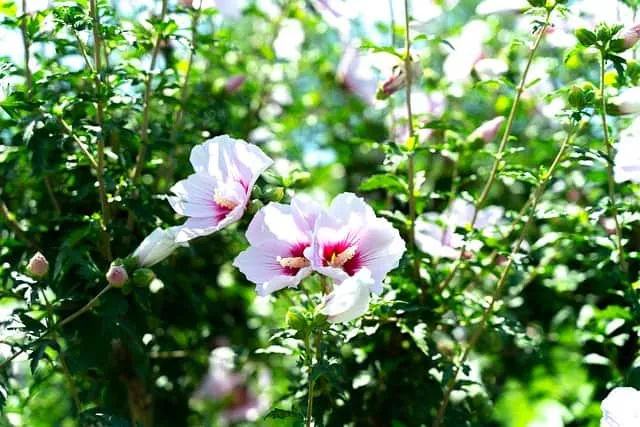
In addition to the major spring pruning, consider light mid-summer pruning to manage the size and shape throughout the growing season. However, be aware that this may slightly reduce the number of blooms in the current year.
Lastly, always ensure that the final shape of the shrub is maintained by pruning the branches to different heights. This will encourage the shrub to grow in a more rounded and visually pleasing shape, maintaining the overall aesthetic of your garden.
Is it possible to propagate a rose of Sharon through cuttings?
Yes, it’s entirely possible. This method allows gardeners to reproduce exact clones of a prized plant. Begin by taking a cutting from a healthy, disease-free branch, ideally in the spring when the plant’s growth is most vigorous. The cutting should be about six inches long and taken from the current year’s growth. It should also have at least two or three nodes (the bumps where leaves attach to the stem), as this is where the new roots will emerge.
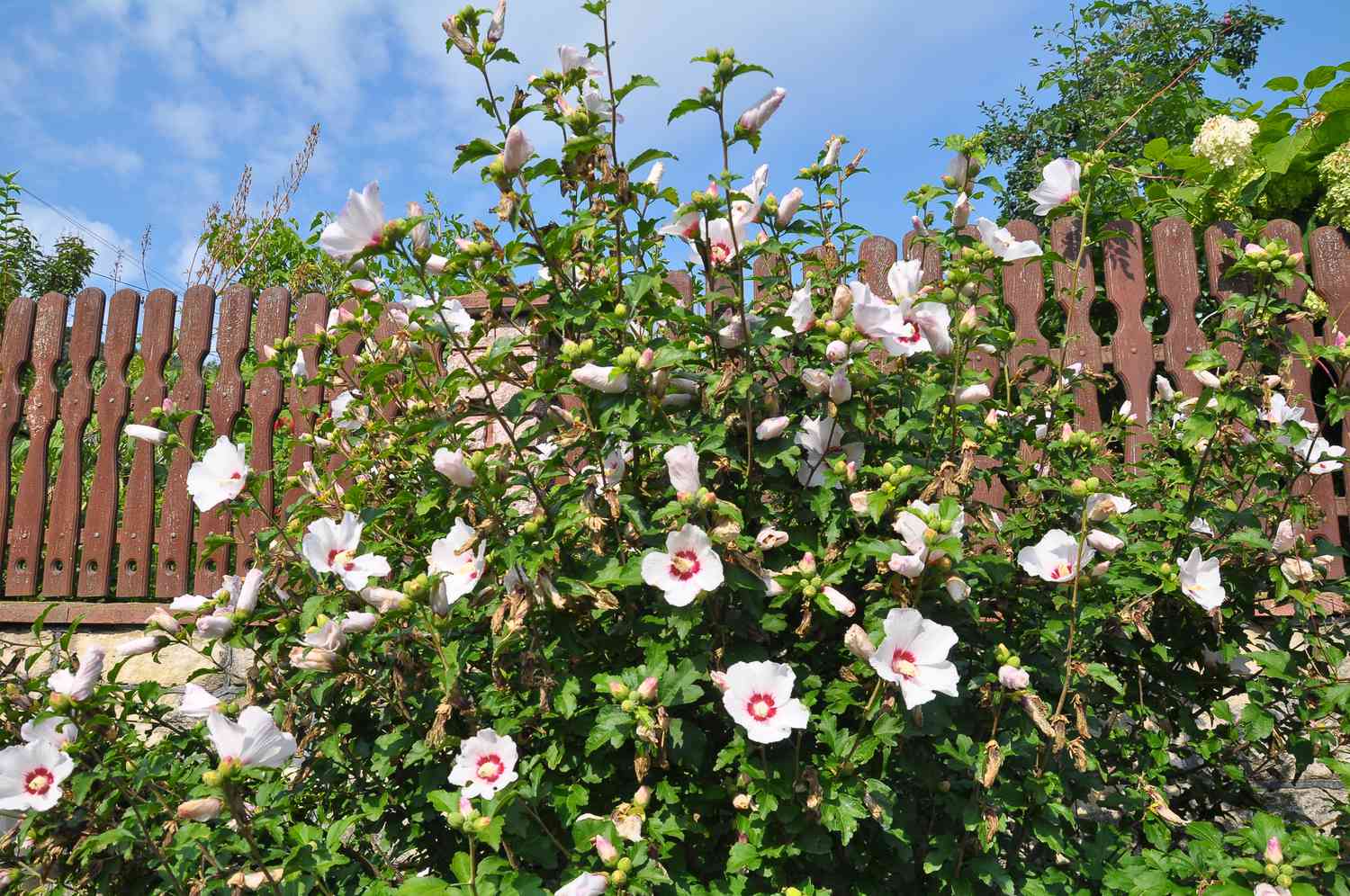
Remove the leaves from the bottom half of the cutting, and then dip the cut end into a rooting hormone. This will enhance the cutting’s chances of successfully developing roots. Plant the cutting in a pot filled with a mixture of perlite and peat moss. Keep the soil moist and place the pot in an area with indirect sunlight.
With proper care, the cutting should begin to develop roots in a few weeks. After it has established a robust root system, it can be transplanted into your garden. This method of propagation can be a cost-effective and rewarding way to expand your Rose of Sharon collection.[5]
FAQ
Is it possible to maintain a compact size for Rose of Sharon?
It is possible to maintain a more compact size for your Rose of Sharon. By implementing consistent and strategic pruning, you can manage the size and shape of the plant. Regular hard pruning, especially in the early spring, helps control the shrub’s size. Additionally, light pruning in mid-summer can help manage the size throughout the growing season. Remember, this shrub grows fairly quickly, so don’t hesitate to cut back branches that outgrow your desired size. With these techniques, you can keep your Rose of Sharon compact and well-shaped.
How often should I prune my Rose of Sharon for size control?
Prune your Rose of Sharon twice a year to maintain its size. Aim for hard pruning once in the early spring and then lighter pruning in mid-summer. In addition, selective removal of longer branches during the growing season will also help keep the shrub within the desired size. With these methods, you can effectively control the size and shape of your Rose of Sharon all year round. [3]
What other benefits does pruning my Rose of Sharon provide?
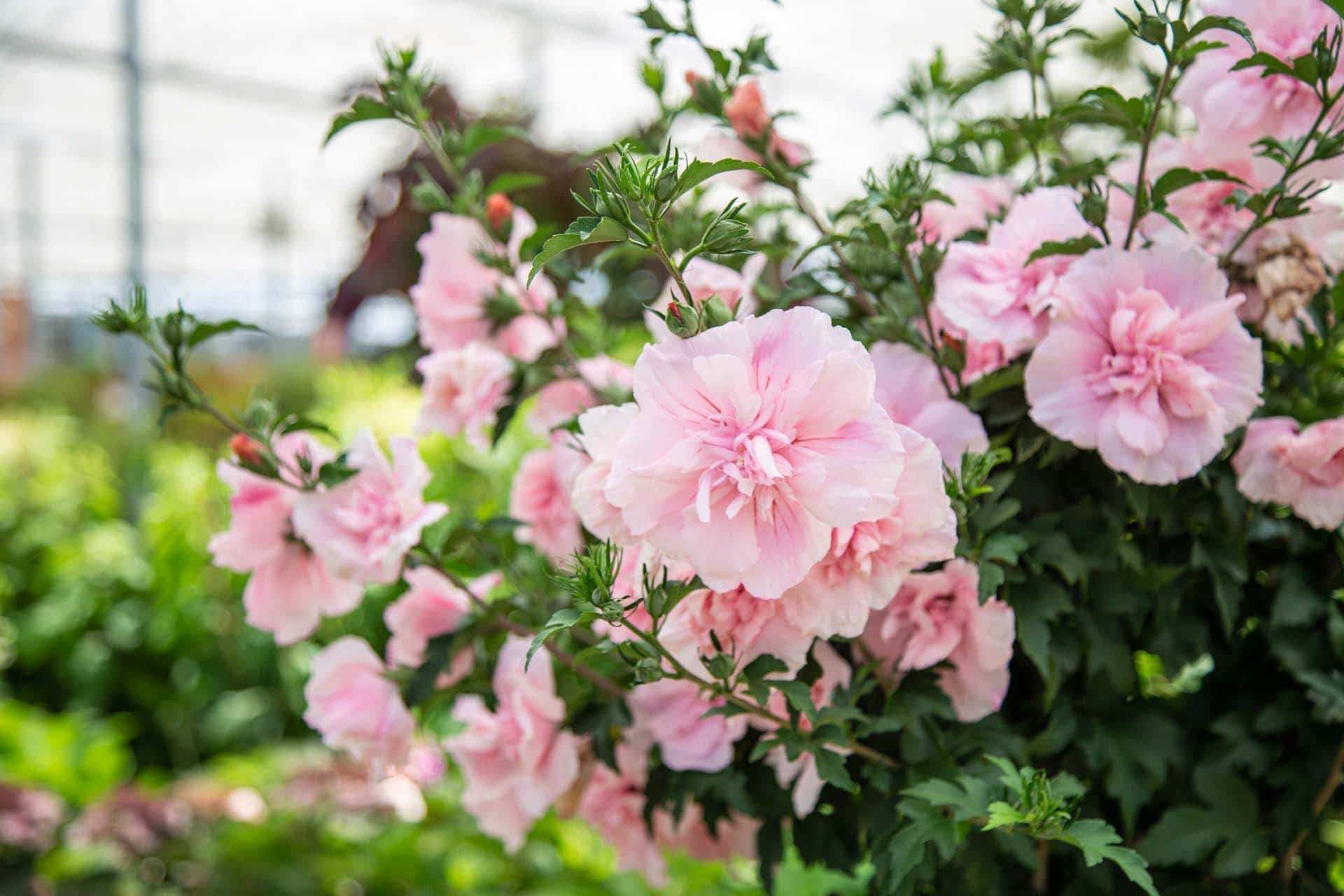
Pruning is essential for maintaining the health and aesthetic of your Rose of Sharon shrub. In addition to managing size, regular pruning helps remove dead or diseased branches. This will help prevent the spread of disease and ensure your Rose of Sharon is healthy and blooming. Pruning also helps to open up the shrub, allowing for better air circulation and sun exposure. Finally, pruning can be used to shape the shrub into a more pleasing form. All these benefits make regular pruning an important part of caring for your Rose of Sharon.
Can I cover my Rose of Sharon with mulch?
Yes, it is a good idea to use mulch around your Rose of Sharon shrub. Mulching can help preserve moisture in the soil and keep the root system from drying out. In addition, it can help insulate the roots during colder months and prevent weed growth. A mulching layer of 2-3 inches is ideal, as it will provide the shrub with all the benefits mentioned without causing any damage. Be sure to use biodegradable mulch such as leaves or grass clippings for an eco-friendly option. With proper care and mulching, you can keep your Rose of Sharon looking beautiful for years to come. [4]
How do I prune a rose of Sharon plant to achieve the desired shape?
Achieving the desired shape for your Rose of Sharon plant requires careful and strategic pruning. Start by removing any dead or damaged wood, as this will enable the plant to focus energy on new growth.
Then, identify the strongest, healthiest stems to serve as the main structure of the plant. Cut away any stems that are crossing or rubbing against these main stems, as this can damage the plant over time.
To encourage a rounded shape, prune the branches at varying heights. Make your cuts just above an outward-facing bud to encourage growth in that direction. This technique will help to open up the plant, allowing better air circulation and light penetration, essential for the health of your Rose of Sharon.
Remember to clean your pruning tools before and after use to prevent the spread of disease. Lastly, be patient. It might take a season or two to achieve the desired shape. But with consistent care and attention, your Rose of Sharon can be coaxed into a beautiful and aesthetically pleasing form.
Is it necessary to deadhead my rose of Sharon?
Deadheading, or the act of removing faded blooms, is not strictly necessary for the Rose of Sharon as it tends to drop its spent flowers on its own. However, some gardeners choose to deadhead their plants to maintain a tidier appearance. Additionally, deadheading can help stimulate further blooming by redirecting the plant’s energy from seed production to new growth. If you choose to deadhead, simply clip off the spent flowers where they connect to the stem. But remember, the Rose of Sharon is a robust plant that will thrive with or without deadheading, so the choice ultimately depends on your gardening style and aesthetic preference.[6]
How long does it take for a Rose of Sharon to fully grow?
The growth rate of a Rose of Sharon can vary depending on the conditions it’s grown in. However, on average, you can expect a Rose of Sharon to reach its full height in approximately 3 to 5 years. It’s worth noting that this plant is known for its vigorous growth and can reach heights of 8-10 feet, with a similar spread. Although the initial growth might seem slow, the Rose of Sharon will typically show a significant growth spurt in its third year. To encourage healthy and swift growth, make sure your Rose of Sharon is planted in well-drained soil and receives plenty of sunlight.
How to make a rose of Sharon bloom?
Encouraging a Rose of Sharon to bloom involves a combination of proper planting, appropriate watering, and balanced feeding. First, ensure your plant is positioned in an area that receives full sunlight – a minimum of six hours per day is ideal. Note that while this shrub can tolerate partial shade, too much shade can deter blooming.
Secondly, maintain consistent watering. While the Rose of Sharon is drought-tolerant once established, it requires regular watering during its first few growing seasons and dry spells.
Additionally, feeding your Rose of Sharon with a balanced fertilizer in early spring can promote blooming. Choose a fertilizer with a balanced ratio of nitrogen (N), phosphorus (P), and potassium (K), such as a 10-10-10.
Remember, too much nitrogen can encourage leafy growth at the expense of blooms.
Lastly, pruning is essential. Pruning in late winter or early spring helps to invigorate the shrub and encourages the growth of new flowering stems. Remove dead, weak or overcrowded branches, and cut back the remaining branches to about a third of their length.
With these steps, you can stimulate your Rose of Sharon to produce an abundance of beautiful blooms.[4]
How tall should a Rose of Sharon be?
The height of a Rose of Sharon shrub largely depends on the specific variety and growing conditions, but generally, they can grow anywhere from 8 to 12 feet tall. Some varieties might stay smaller, around 6 feet in height. These plants can be pruned to maintain a desired height or shape, but remember, their natural tendency is to grow fairly tall. Also, keep in mind that Rose of Sharon is not only tall but also spreads wide, typically reaching a width similar to its height. If you are planning to add a Rose of Sharon to your garden, ensure you have ample space to accommodate its potential size.
What makes the Rose of Sharon truly remarkable?
The Rose of Sharon is a truly remarkable plant for several reasons. First, its stunning, large, trumpet-shaped flowers make a dramatic visual impact in any garden. The blooms come in a range of beautiful colors, from pure white to deep red, with many showcasing a contrasting eye in the center. This plant’s prolonged blooming period, from mid-summer to early fall, provides vibrant color when many other plants are starting to fade.
Moreover, the Rose of Sharon is highly adaptable. It thrives in a wide range of soil types and is remarkably resilient, tolerating both heat and drought conditions once established. This makes it an excellent choice for gardeners in a variety of climates.
Finally, the Rose of Sharon’s height and spread provides fantastic structure and dimension to garden landscapes. It can be used as a stunning standalone specimen, an attractive hedge, or even a privacy screen. Despite its elegant appearance, this shrub is low maintenance, requiring minimal care once established, making it a favored choice among both novice and experienced gardeners.[3]
Is Rose of Sharon the same as Hibiscus?
Yes, the Rose of Sharon (Hibiscus syriacus) is a variety of hibiscus. While it shares the genus ‘Hibiscus’ with many other species, it’s important to note that not all hibiscus plants are Roses of Sharon. This plant is most commonly associated with the hibiscus family due to the similar characteristics of their flowers, but it is different from the tropical hibiscus (Hibiscus rosa-sinensis) that most people think of when they hear the term “hibiscus”. The tropical hibiscus is not winter hardy and thus, is typically grown as a potted plant in cooler climates. On the other hand, the Rose of Sharon is hardy and can withstand cold winter temperatures, making it a popular choice for outdoor gardening in many regions.
The Rose of Sharon also has a more upright growth habit than many other hibiscus varieties, making it a great choice for gardeners who want an eye-catching statement piece in their landscape. With its vibrant colors and long blooming season, the Rose of Sharon adds charm and visual appeal to gardens. It’s no wonder that this magnificent plant is known as the ‘Queen of Summer’.
What are some tips for planting a Rose of Sharon?
When planting your Rose of Sharon, it’s important to take into account its eventual size and spread. The plant should be placed in an area that provides plenty of space to accommodate its growth. It’s best to position the shrub slightly away from any buildings or structures, to ensure it doesn’t affect them in the future.
Choose an area with full sun exposure that is well-drained and has good air circulation – avoid areas prone to standing water. Rose of Sharon should be planted at least 6 feet away from other plants and trees, as overcrowding can lead to stress for the shrub and inhibit its growth.
Dig a hole large enough for the root ball, then backfill with native soil amended with organic matter.
In conclusion, the Rose of Sharon is a magnificent plant that can add both beauty and structure to any garden. With its drought tolerance, adaptability and long flowering season, it is an excellent choice for both novice and experienced gardeners alike. If you follow our tips for planting and caring for your Rose of Sharon, you’ll be sure to have a stunning display of blooms in no time. [6]
Useful Video: How to Prune Rose of Sharon
Conclusion
In conclusion, the Rose of Sharon is a robust and beautiful shrub that can add vibrancy and color to any garden. Its care involves strategic pruning for health and shape, optional deadheading for appearance, and mindful feeding and watering for optimal blooming. Remember, patience is key when growing a Rose of Sharon, as it may take a few seasons to reach its full potential. But with careful attention and proper care, you can enjoy the beauty of this plant year after year. Whether you’re a novice gardener or a seasoned horticulturist, the Rose of Sharon makes a delightful addition to any outdoor space.
References:
- https://www.wikihow.com/Prune-Rose-of-Sharon
- https://stutzmans.com/rose-sharon-care-pruning/
- https://plantaddicts.com/pruning-rose-of-sharon/
- https://triblive.com/lifestyles/home-garden/rose-of-sharon-isnt-fussy-about-how-or-when-its-pruned/
- https://www.dispatch.com/story/lifestyle/home-garden/how-to/2009/08/30/rose-sharon-can-start-from/23531830007/
- https://www.britannica.com/plant/rose-of-Sharon





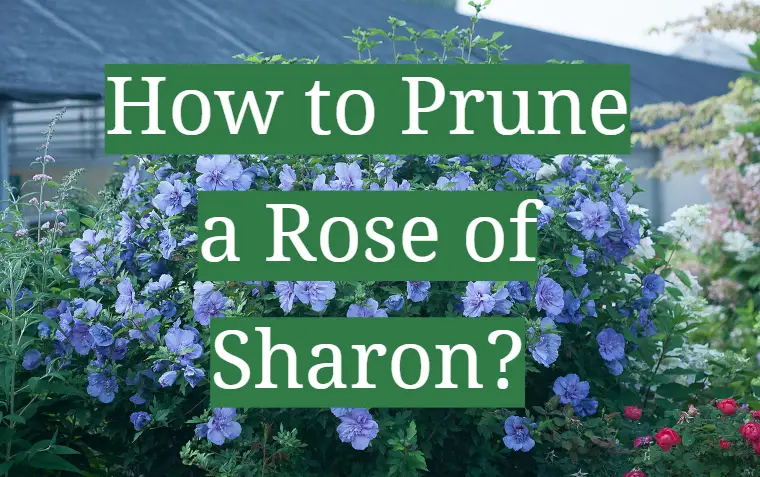




Leave a Reply
View Comments